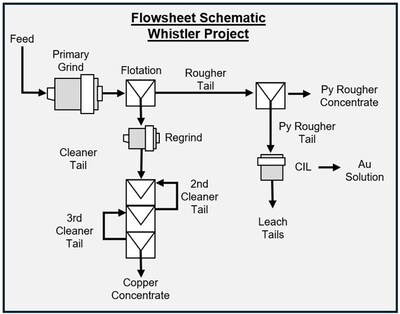Metallurgical Test Work Improves Gold Recovery to 85% (+22%) for the Whistler Gold-Copper Project, Alaska
Rhea-AI Summary
U.S. GoldMining (NASDAQ: USGO) announced improved metallurgical test results for its Whistler Gold-Copper Project in Alaska. The updated test work achieved 85.3% gold recovery, marking a significant 22% improvement over previous results. The process combines sulphide flotation and leaching techniques, with the flotation producing a copper concentrate grading 23.7% Cu with 79.1% copper and 54.1% gold recovery, while subsequent leaching recovered an additional 31.2% gold.
The test program, conducted by Base Metallurgical Laboratories, included 28 flotation tests and four leach tests using master composites and variability samples. The results will provide crucial inputs for the company's ongoing Preliminary Economic Assessment (PEA). The process flowsheet employs proven technology to produce both marketable copper concentrate and gold doré through a simple but effective approach.
Positive
- Significant improvement in gold recovery to 85.3% (22% increase from previous tests)
- High-grade copper concentrate achieved at 23.7% Cu with strong recoveries (79.1% Cu, 54.1% Au)
- Process uses proven technology combining flotation and leaching
- Modest reagent consumption in leaching process (0.48 kg/t NaCN and 1.28 kg/t lime)
- Additional optimization opportunities identified through future variability testing
Negative
- Ore classified as 'Hard' to 'Very Hard', indicating potentially higher processing costs
- Additional variability test work still required for comprehensive deposit representation
- Silver recovery remains relatively low at 55.3%
Insights
U.S. GoldMining's new metallurgical tests increased gold recovery from 70% to 85.3% at Whistler, significantly enhancing project economics.
The new metallurgical test work results for the Whistler Gold-Copper Project in Alaska represent a significant technical breakthrough with substantial economic implications. By combining conventional sulphide flotation with sequential leaching, U.S. GoldMining has achieved an 85.3% gold recovery rate - a 22% improvement over previous test work that only utilized flotation.
The technical approach is particularly elegant in its simplicity. The dual-stream process first produces a high-grade copper concentrate (23.7% Cu) with acceptable precious metals recovery (54.1% Au, 55.3% Ag), then captures an additional 31.2% gold through cyanidation of the rougher tails. This approach maximizes revenue streams while using proven, commercially established technologies.
The metallurgical characteristics of the ore (classified as 'Hard' to 'Very Hard') indicate standard crushing and grinding requirements, with optimal recoveries achieved at a primary grind size of 120μm and regrind size of 16μm. These parameters are well within conventional processing capabilities.
Perhaps most significant is what these results mean for project economics. Improved recoveries, especially of gold, translate directly to increased project value. For context, in mining economics, a 10% increase in recovery often provides more value than a 10% increase in resource size, as it requires no additional mining costs. The 22% improvement in gold recovery could substantially enhance the Preliminary Economic Assessment (PEA) currently underway.
While the company indicates further variability testing is needed across different zones of the deposit, the consistency of results from the seven variability tests already performed suggests these recovery rates should be achievable across most of the deposit. The modest reagent consumption in the leaching process (0.48 kg/t NaCN and 1.28 kg/t lime) also indicates reasonable operating costs for this component of the flowsheet.
Highlights:
- Recovery of up to
85.3% gold (Au),79.1% copper (Cu) and55.3% silver (Ag) from the combined sulphide flotation and leaching test work using a master composite derived from Whistler Deposit drill core that is representative of the average metal grade within the Project's mineral resource estimate ("MRE").- Sulphide flotation locked cycle tests ("LCT") produced a copper concentrate grading
23.7% Cu with a0.6% mass pull at a P80 grind size of 120µm (rougher circuit) and a regrind of 16µm (cleaner circuit). The initial concentrate metal recoveries include54.1% Au,79.1% Cu and55.3% Ag. - Leach testing of the rougher sulphide flotation circuit tails recovered an additional
31.2% Au, for the combined overall recovery of85.3% Au.
- Sulphide flotation locked cycle tests ("LCT") produced a copper concentrate grading
- A total of 28 flotation tests were completed together with four leach tests on a combination of master composites and variability samples that were conducted by Base Metallurgical Laboratories Ltd., of
Kamloops, B.C. ,Canada . - The Program results provide key metallurgical recovery and process flowsheet inputs to the initial economic assessment (the "PEA").
Tim Smith, Chief Executive Officer of U.S. GoldMining, commented: "The Company is delighted with the 2025 metallurgical test work results which have confirmed that high gold recoveries in excess of
2025 Metallurgical Program Details
Sample Selection and Preparation
The 2025 metallurgical test program had the objective of achieving optimized metal recovery results from a set of Whistler Deposit drill core samples. To this end, sampling was completed on fresh 2023 and 2024 drill core comprising seven quarter core composites assembled from four drill holes (WH23-01, WH23-02, WH23-03 and WH24-02). These composites were further homogenized down to a single Master Composite that was selected to represent the global average resource grade from the 2024 MRE (see news release dated October 7, 2024).
Crushing and Grinding Testwork
Comminution tests were completed on the master composite material resulting in being classified as 'Hard' to 'Very Hard'. From preliminary test work, a primary grind size of 120 µm was selected with a secondary grind (regrind) size of 16 µm to yield the optimal recoveries.
Flotation Testwork
A series of rougher flotation tests were completed, followed by cleaner flotation tests, which set the design criteria for a final series of locked cycle tests. The final test circuit (LCT28) consisted of the rougher concentrate reporting to a copper cleaner circuit to produce a copper concentrate of
Table 1 Results of sulphide flotation test work to produce a saleable copper concentrate. Test ID LCT28 produced final optimized recoveries of
Type | Sample | Head | Head | Head | TestID | Product | Mass % | Con Grade | Cu Rec | Au Rec | Ag Rec |
OCT | WC-Var 1 | 0.16 | 1.35 | 1.50 | C21 | 1st Cln Con | 0.5 | 21.6 | 68.2 | 49.7 | 32.9 |
OCT | WC-Var 2 | 0.11 | 0.45 | 0.80 | C22 | 1st Cln Con | 0.4 | 21.3 | 64.5 | 49.2 | 40.6 |
OCT | WC-Var 3 | 0.18 | 0.06 | 0.80 | C23 | 1st Cln Con | 0.7 | 25.3 | 82.2 | 60.0 | 57.0 |
OCT | WC-Var 4 | 0.29 | 0.88 | 2.10 | C24 | 1st Cln Con | 0.9 | 25.4 | 74.7 | 61.3 | 43.1 |
OCT | WC-Var 5 | 0.28 | 0.41 | 1.20 | C25 | 1st Cln Con | 0.8 | 29.7 | 83.7 | 62.3 | 44.3 |
OCT | WC-Var 9 | 0.14 | 0.22 | 4.20 | C26 | 2nd Cln Con | 0.5 | 20.5 | 65.8 | 54.6 | 46.9 |
OCT | WC-Var 10 | 0.20 | 0.78 | 0.90 | C27 | 2nd Cln Con | 0.6 | 29.2 | 82.5 | 74.5 | 49.6 |
OCT | Master | 0.17 | 0.43 | 0.80 | C09 | 3rd Cln Con | 0.5 | 24.9 | 77.5 | 50.6 | 41.9 |
LCT | Master | 0.17 | 0.43 | 0.80 | LCT28 | Final | 0.6 | 23.7 | 79.1 | 54.1 | 55.3 |
Seven variability tests were performed to determine variability across rock types in both the rougher and cleaner circuits. All tests were completed in an open circuit configuration with sequential rougher flotation, regrind of the rougher concentrate and three sequential cleaning circuits to produce a final concentrate product. Results from all tests were favorably comparable with no significant outliers. Observed metal recoveries from sulphide flotation were as high as
Gold Leaching Testwork
Pyrite rougher tails from the locked cycle tests were subsequently subjected to cyanidation (NaCN) leach testing, with a final extraction of
Table 2 Summary metallurgical test results for sulphide flotation (LCT 28, see Table 1) to produce a copper concentrate, plus subsequent Py rougher concentrate and cyanidation leaching of the Py concentrate tails.
Product | Sample | Assay - percent or g/t | Distribution - percent | |||||||
% | grams | Cu % | Au g/t | Ag g/t | S % | Cu % | Au % | Ag % | S % | |
Feed | 100 | 3,971.4 | 0.18 | 0.39 | 1.0 | 0.93 | 100 | 100 | 100 | 100 |
Cu Cleaner Concentrate | 0.6 | 24.1 | 23.7 | 35.0 | 92 | 27.6 | 79.1 | 54.1 | 55.3 | 18.0 |
Py Rougher Concentrate | 4.0 | 157.7 | 0.17 | 1.06 | 4.1 | 9.10 | 3.8 | 10.7 | 16.2 | 38.9 |
Py Rougher Tail Leach | 95.4 | 3,789.6 | 0.033 | 0.15 | 0.3 | 0.42 | 17.1 | 35.2 | 28.5 | 43.1 |
Combining gold recovery from both the copper concentrate and from leaching thus provides a final gold recovery of
About U.S. GoldMining Inc.
U.S. GoldMining Inc. is an exploration and development company focused on advancing the
For further information regarding the Project, refer to the technical report summary titled "S-K 1300 Technical Report Summary Initial Assessment for the Whistler Project,
Tim Smith, P.Geo., Chief Executive Officer of the Company, has supervised the preparation of this news release and has reviewed and approved the additional scientific and technical information contained herein. Mr. Smith is a "qualified person" as defined under NI 43-101.
Visit www.usgoldmining.us for more information.
Forward-Looking Statements
Except for the statements of historical fact contained herein, the information presented in this news release constitutes "forward-looking statements" within the meaning of
![]() View original content to download multimedia:https://www.prnewswire.com/news-releases/metallurgical-test-work-improves-gold-recovery-to-85-22-for-the-whistler-gold-copper-project-alaska-302562547.html
View original content to download multimedia:https://www.prnewswire.com/news-releases/metallurgical-test-work-improves-gold-recovery-to-85-22-for-the-whistler-gold-copper-project-alaska-302562547.html
SOURCE U.S. GoldMining Inc.










